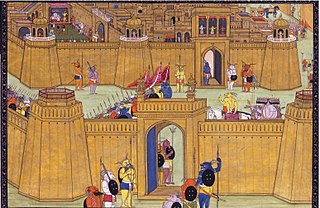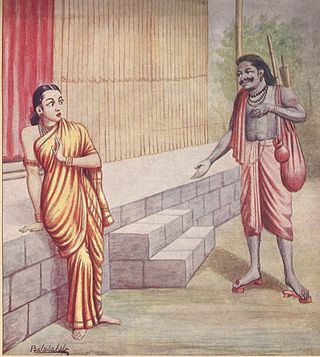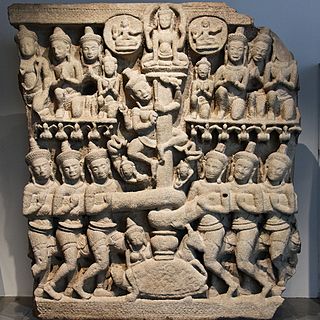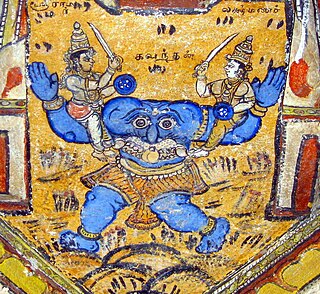Related Research Articles

Rākshasas are a race of usually malevolent beings prominently featured in Hindu mythology. They reside on Earth but possess supernatural powers, which they usually use for evil acts such as disrupting Vedic sacrifices or eating humans.

Lanka is the name given in Hindu epics to the island fortress capital of the legendary asura king Ravana in the epics of the Ramayana and the Mahabharata. The fortress was situated on a plateau between three mountain peaks known as the Trikuta Mountains. The ancient city of Lankapura is said to have been burnt down by Hanuman. After its king, Ravana was killed by Rama with the help of Ravana's brother Vibhishana, the latter was crowned king of Lankapura. His descendants were said to still rule the kingdom during the period of the Pandavas. According to the Mahabharata, the Pandava Sahadeva visited this kingdom during his southern military campaign for the rajasuya of Yudhishthira. The palaces of Ravana were said to be guarded by four-tusked elephants.

In the Hindu epic Ramayana, Maricha, or Mareecha is a rakshasha, who was killed by Rama, the hero of the epic and an avatar of Lord Vishnu. He is mentioned as an ally of Ravana, the antagonist of the epic. His most notable exploit is his role in the kidnapping of Sita, Rama's wife. His son Kalanemi was killed by Hanuman.

Lakshmana Rekha, in some later versions of the Hindu epic Ramayana, is a line in the soil drawn by Lakshmana. This line is drawn around the dwelling in the forest that he shared with his elder brother, Rama, and Rama's wife, Sita. The line is meant to protect Sita, while he was away searching for Rama. This line is not featured in the original epic by Valmiki.

In Hinduism, Vanara are either monkeys, apes, or a race of forest-dwelling people.

Sugriva is a character In the ancient Indian epic Ramayana. He is the younger brother of Vali, whom he succeeded as ruler of the vanara kingdom of Kishkindha. Rumā is his wife. He is a son of Surya, the Hindu deity of the sun. As the king of the vanaras, Sugriva aided Rama in his quest to liberate his wife Sita from captivity at the hands of the rakshasa king Ravana.

Vali, also known as Bali, was a vanara king of Kishkindha in the Hindu epic Ramayana. He was the husband of Tara, the son of Indra, the elder brother of Sugriva, and the father of Angada.

Sita also known as Siya, Janaki, Maithili, Vaidehi and Bhumija is a Hindu goddess and the female protagonist of the Hindu epic, Ramayana. She is the consort of Rama, the avatar of the god Vishnu, and is regarded as a form of Vishnu's consort, Lakshmi. She is also the chief goddess of Rama-centric Hindu traditions. Sita is known for her dedication, self-sacrifice, courage, and purity. She is one of the eighteen national heroes of Nepal.

Hindu mythological wars are the wars described in the Hindu texts of ancient India. These wars depicted both mortals of great prowess as well as deities and supernatural beings, often wielding supernatural weapons of great power. Hindu teachings prescribe war as the final option, to be employed only after all peaceful methods are exhausted. Participation in righteous war, or dharmayuddha, was said to be honourable and was a principal duty of the Kshatriya or the warrior varna, and victory in such wars was regarded as a matter of honour.

Shurpanakha, is a rakshasi (demoness) in Hindu epic. Her legends are mainly narrated in the epic Ramayana and its other versions. She was the sister of Lanka's king, Ravana, and the daughter of the sage Vishrava and the rakshasi Kaikeshi. Shurpanakha's role in the original epic is small, yet significant.
Nishada is a tribe mentioned in ancient Indian literature. The ancient texts mention several kingdoms ruled by this tribe. In the Mahabharata, the Nishadas are described as hunters, fishermen, mountaineers or raiders that have the hills and the forests as their abode. They are linked with a king called Vena who became a slave to wrath and malice, and became unrighteous. Sages killed him for his malice and wrongdoings. In the epic Valmiki Ramayan there is a character named Guha who is from the Nishada clan, whom the central character of the epic Sri Ramchandra called him 'aatmasamam' which literally means equal to his soul or among the best friends. There we also find praises of the Nishad community by the central character Shri Ramchandra for the contribution of Nishad community leader Guha in the internal and external security of the Ayodhya Kingdom.
Rakshasa Kingdom refers to the territory of Rakshasas who were a tribe, mentioned along with others like Devas, Asuras, Pisachas, Gandharvas, Kimpurushas, Vanaras, Suparnas, Kinnaras, Bhutas and Yakshas. Rakshasas were described to have large bodies, probably due to their continuous life in cold climates over snow-covered mountains. The forefathers of the famous Rakshasa king Ravana lived along with the Yakshas. The Yaksha king Kubera was the elder brother of Rakshasa king Ravana. Ravana had many sons among Gandharva wives. The two epics Mahabharata and Ramayana and many Puranas attest that Rakshasas, Yakshas and Gandharvas were related and had inter-marriages.

Kishkindha is a kingdom of the vanaras in Hinduism. It is ruled by King Sugriva, the younger brother of Vali, in the Sanskrit epic Ramayana. According to the Hindu epic, this was the kingdom that Sugriva ruled with the assistance of his counsellor, Hanuman.

Dandakaranya is a historical region in India, mentioned in the Ramayana. It covers about 92,200 square kilometres (35,600 sq mi) of land, which includes the Abujhmar Hills in the west and the Eastern Ghats in the east, including regions of Andhra Pradesh, Maharashtra, Chhattisgarh, Odisha, Telangana and Karnataka states. It spans about 300 kilometres (200 mi) from north to south and about 500 kilometres (300 mi) from east to west. Dandakaranya roughly translates from Sanskrit to "The Jungle (aranya) of Danda ."
In Hinduism, an astra was a supernatural weapon, presided over by a specific deity and imbued with spiritual and occult powers that caused its effect or impact. Later the word came to denote any weapon which was used by releasing it from one's hand, compared to keeping it one's hand (Shastra). In Ramayana and Mahabharata, Rama had more astras than any other warrior. It is believed that Rama possessed all the astras.

In Hinduism, Kabandha is a Rakshasa (demon) who is killed and freed from a curse by the god Rama – an Avatar of Vishnu – and his brother Lakshmana. Kabandha's legend appears in the Hindu epics Ramayana and Mahabharata, as well as in later Ramayana adaptations.
The following is a list of the avatars of the epic Mahabharata, and their original devatas (deities) or other beings.

The Panchakanya is a group of five iconic women of the Hindu epics, extolled in a hymn and whose names are believed to dispel sin when recited. They are Ahalya, Draupadi, Sita, Tara, and Mandodari. While Draupadi is from the Mahabharata, Ahalya, Sita, Tara, and Mandodari are from the Ramayana. The Panchakanya are regarded to be ideal women who exemplify perfect wives in Hinduism.

Nila, also spelled as Neela, is a character in the Hindu epic Ramayana. He is a vanara chieftain in the army of Rama, the prince of Ayodhya and avatar of the god Vishnu. He is the commander-in-chief of the vanara army under the vanara king Sugriva, and is described as leading the army in Rama's battle against the rakshasa king Ravana of Lanka and as killing many rakshasas.
References
- ↑ "Vedicfeed - Vedic Knowledge and Information". vedicfeed.com. 13 February 2022. Retrieved 11 April 2023.
- ↑ "PeepulTree" . Retrieved 11 April 2023.
- ↑ www.wisdomlib.org (29 June 2012). "Dandaka, Daṇḍaka, Daṇḍakā, Damdaka: 30 definitions". www.wisdomlib.org. Retrieved 11 April 2023.
- ↑ Meyerson, Joel D. (1986). Images of a Lengthy War. Center of Military History, U.S. Army. ISBN 978-0-16-001620-2.
- ↑ "7 Most Mystical Places In Asia in 2023". www.holidify.com. Retrieved 11 April 2023.
- ↑ "Valmiki Ramayana - Baala Kanda - Sarga 24". www.valmikiramayan.net. Retrieved 11 April 2023.
- ↑ "Mahabharata | Definition, Story, History, & Facts | Britannica". www.britannica.com. Retrieved 11 April 2023.
- ↑ "The Mahabharata, Book 2: Sabha Parva: Jarasandhta-badha Parva: Section XXX". www.sacred-texts.com. Retrieved 11 April 2023.
- ↑ "The Mahabharata, Book 2: Sabha Parva: Jarasandhta-badha Parva: Section XXX". www.sacred-texts.com. Retrieved 11 April 2023.
- ↑ "The Mahabharata, Book 3: Vana Parva: Tirtha-yatra Parva: Section LXXXV". www.sacred-texts.com. Retrieved 11 April 2023.
- ↑ "The Mahabharata, Book 3: Vana Parva: Tirtha-yatra Parva: Section C". www.sacred-texts.com. Retrieved 11 April 2023.
- ↑ "The Mahabharata, Book 1: Adi Parva: Sambhava Parva: Section LXXXV". www.sacred-texts.com. Retrieved 11 April 2023.
- ↑ "The Mahabharata, Book 1: Adi Parva: Sambhava Parva: Section LXXXV". www.sacred-texts.com. Retrieved 11 April 2023.